| |
|
| |
Wild Desert Resort |
|
|
|
|
|
|
| |
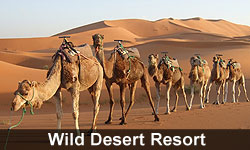 |
|
| |
| |
An Adventure on sand dunes and same. get a feel of shifting sand dunes Capturing the spirit of Sand Dunes and ensuring the perfect Dunes experience at Wild desert resort, a unique Sam Dunes Resort and Camp. |
|
|

|
|
|
|
|
|
|
| Delhi |
Red Fort
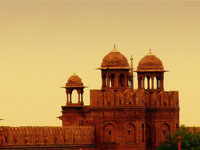 Delhi's most famous monument, the Red Fort, stands as a powerful reminder of the Mughal emperors who ruled India. Its walls, which stretch for over two kilometers (1.2 miles), were built in 1638 to keep out invaders. However, they failed to stop the fort being captured by the Sikhs and the British. To take your imagination back to the ancient era, a one hour sound and light show of the fort's history is held each evening.
Delhi's most famous monument, the Red Fort, stands as a powerful reminder of the Mughal emperors who ruled India. Its walls, which stretch for over two kilometers (1.2 miles), were built in 1638 to keep out invaders. However, they failed to stop the fort being captured by the Sikhs and the British. To take your imagination back to the ancient era, a one hour sound and light show of the fort's history is held each evening.
- Location: Opposite Chandni Chowk, Old Delhi.
- Entry Cost: $5 or 250 rupees. Free for children under 15 years.
- Opening Hours: Sunrise until sunset. Closed Mondays.
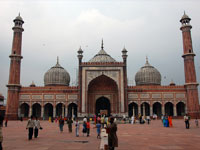 Jama Masjid Jama Masjid
Jama Masjid is another marvelous treasure of the Old City, and is the largest mosque in India. Its courtyard can hold an incredible 25,000 devotees. The mosque took 13 years to build, and was completed in 1650. A strenuous climb to the top of its southern tower will reward you with a stunning view across the rooftops of Delhi. Be sure to dress appropriately when visiting the mosque or you won't be allowed in. This means covering your head, legs and shoulders. Attire is available there.
- Location:Opposite Chandni Chowk, Old Delhi. Near the Red Fort.
- Entry Cost:Free, but a camera fee applies.
- Opening Hours:Daily, except when prayers are being held from 12.15 p.m. to 1.45 p.m. It closes just before sunset.
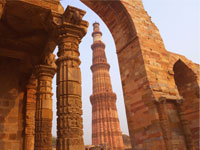 Qutab Minar Qutab Minar
Qutab Minar, the tallest brick minaret in the world, is an incredible example of early Indo–Islamic architecture. It was built in 1206, but the reason remains a mystery. Some believe that it was made to signify victory and the beginning of Muslim rule in India, while others say it was used to call the faithful to prayer. The tower has five distinct stories, and is covered with intricate carvings and verses from the holy Quran. There are also a number of other historic monuments on the site.Visit the India Travel Forum for an interesting set of photos of Qutab Minar, posted by one of the members.
- Location:Mehrauli, south New Delhi.
- Entry Cost:: $5 or 250 rupees. Free for children under 15 years.
- Opening Hours:Sunrise until sunset, daily.
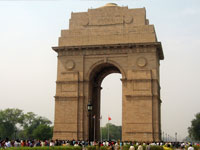 India Gate
The towering archway of India Gate at the center of New Delhi is a war memorial, built in memory of the Indian soldiers who lost their lives fighting for the British Army in World War I. At night it glows warmly under floodlights, and the gardens that line its boulevard are a popular place to enjoy a warm summer's evening. India Gate
The towering archway of India Gate at the center of New Delhi is a war memorial, built in memory of the Indian soldiers who lost their lives fighting for the British Army in World War I. At night it glows warmly under floodlights, and the gardens that line its boulevard are a popular place to enjoy a warm summer's evening.
- Location:Rajpath, near Connaught Place, New Delhi.
- Entry Cost::Free.
- Opening Hours:Always open.
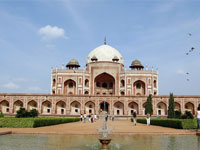 Humayun's Tomb Humayun's Tomb
If you think Humayun's Tomb looks a bit like the Taj Mahal in Agra, that's because it was the inspiration for the Taj Mahal's creation. The tomb was built in 1570, and houses the body of the second Mughal emperor, Humayun. It was the first of this type of Mughal architecture to be built in India, and the Mughal rulers followed it up with an extensive period of construction all over the country. The tomb is part of a greater complex that's set amongst beautiful gardens.
- Location:: Nizamuddin East, New Delhi. Near the Nizamuddin train station, off Mathura Road.
- Entry Cost:: $5 or 250 rupees. Free for children under 15 years.
- Opening Hours: Sunrise until sunset, daily. It's best viewed in the golden light of the late afternoon.
By Air
Delhi is well connected with domestic and international flights, to all the major cities within and outside India. Almost all the major airlines have their flights operating from Indira Gandhi International Airport at New Delhi. Domestic Airport connects Delhi to the major cities in India.
By Train
The railway network connects Delhi to the all major and, nearly, all the minor destinations in India. The three important railway stations of Delhi are New Delhi Railway Station, Old Delhi Railway Station and Hazrat Nizamuddin Railway Station.
By Road
Delhi is well connected, by a network of roads and national highways, with all the major cities in India. The three major bus stands in Delhi are Inter State Bus Terminus (ISBT) at Kashmiri Gate, Sarai Kale-Khan Bus Terminus and Anand Vihar Bus Terminus. Both the government and private transport providers provide frequent bus services. One can also get government as well as private taxis here.
Festivals:
Lohri (January) : In this festival, the climax of winter is celebrated with bonfires and singing. Traditionally, Lohri marks the end of winter.
Makar Sakranti (January) : A major harvest festival of India. It is one of the biggest events in the states of Tamilnadu, Karnataka and Andhra Pradesh. But fights and bullock race is an important feature of the celebrations. Also celebrated in the eastern region when millions of piligrims take a holy dip in the Ganges.
Maha Shivratri (March) : Maha Shivratri is celebrated on the 'Amavasya' (no moon) night of 'Phalguna'. It is said Lord Shiva danced the 'Tandava Nritya', which means cosmic dance on this dark night. He is worshipped at temples with all night vigils and prayers and unmarried women keep day-long fasts so that Shiva may grant them good husbands.
Baisakhi (13th April) : In north India, the Hindu New Year is celebrated on Baisakhi in mid-April just as the sun begins to get fierce and the dusty winds herald summer. It is also known as the beginning of the harvest season.
Easter and Good Friday (April) - Mostly celebrated by Christians in particular but even other people in general.
Buddha Jayanti (May) : The first full moon night in May marks the birth of the Lord Buddha. Prayer meetings are held at Buddha Vihar, Ring Road and Buddha Vihar, Mandir Marg. Buddha Purnima is the month of 'Vaisakha', commemorates not just Lord Buddha's birth, but also his 'Enlightenment' and gaining 'Nirvana'.
|
|
|


